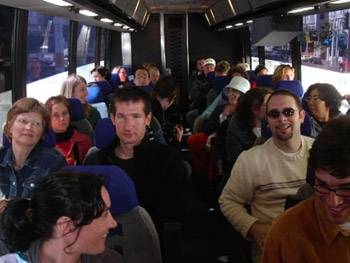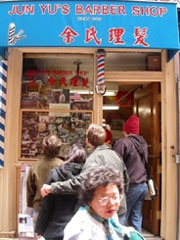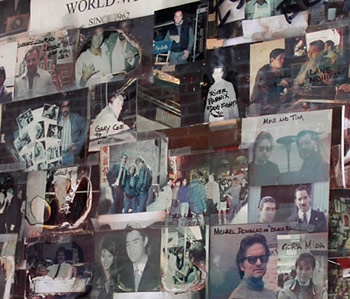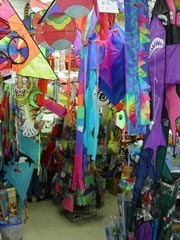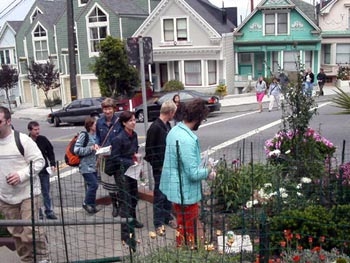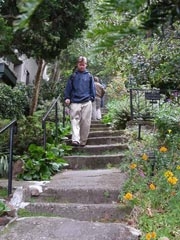Feature: Reviews
Mundane Journeys
An ongoing public artwork by Kate Pocrass
In and around San Francisco
Richard Bennet’s 1974 book The Fall of Public Man details his hypothesis that since the industrial revolution public life has diminished qualitatively at the expense of an increasingly narcissistic dependence on private life and the quest for self-understanding.
This strikes me as particularly relevant in the context of my recent visits to MFA exhibitions this spring. In so many cases the work was overshadowed by ego, as manifested in the obscenely huge vinyl lettering of names, pedestals holding “promotional” material, price lists, and other forms of establishing an official art pedigree. The contrast between “quiet” and “loud” visual experiences was so marked as to seem almost auditory. I was put off by the “loud” marketing of so many artists’ careers, gravitating instead towards “silent” artworks: landscape photography, intimate graphite drawings and other works that require a kind of careful and thoughtful looking. The question I found myself asking was “What constitutes a meaningful artistic experience?”
With these thoughts in mind I boarded the first Mundane Journeys bus tour. Mundane Journeys is an ongoing public artwork/project initiated by Kate Pocrass in August 2001. Every week, through her Web site, telephone hotline and new pocket guide book and bus tour, Pocrass reveals a new place in the city of San Francisco to visit (by walking, bus, or bike) and experience. She calls attention to easily overlooked aesthetic, social and physical phenomena that upon discovery often bring humor, delight and pleasure to those experiencing them. Her dedication to Mundane Journeys and her tandem commitment to civic engagement are remarkable.
The four hour bus tour left from near San Francisco’s City Hall and included three stops: the Chinatown, Richmond, and Upper Market neighborhoods. At each stop participants were given a map with Pocrass’s suggestions of neighborhood sites worth visiting and instructions to return to the bus in exactly forty minutes. Chinatown sites included a barbershop, a kite store, a bakery, a fortune cookie factory, a clock shop and photo studio. The Richmond sites included an odd shaped building, a large fish trapped in a small tank in the window of a restaurant, the 4 Star Theater, pigeon-deterring fake owls on the face of a building, a garish painting of open mouths in a dentist office and more. The Upper Market sites included three neighborhood gardens lovingly maintained by residents of that area. In transit between sites, participants watched an animated video (narrated by Pocrass) that highlighted the cultural or historical significance of some aspect of the next stop.
Mundane Journeys is about wonder—the thrill of discovery, the ownership of experience, the satisfaction of small pleasures. In her pocket guide Pocrass asks us to notice many details—three doors that all are painted a different shade of red, the contrast in texture between the “hairy coconut and gummy rice” in a coconut mochi, the depiction of sparks in a motorized four-cylinder auto display, a painting of a dog behind a fire hydrant. A subtler kind of wonder also develops as we come to know Pocrass herself. The voice mail and written instructions are very intimate in nature. Pocrass speaks in a calm entreating voice and shares many small confidences. We learn that she enjoys eating celery with peanut butter, that a friend used to live in such and such house, that the ugliness of the puffer fish now attracts her, that squeezing a mayonnaise tube feels like squeezing a toddler, and other small details of a life being lived.
The success of this work and its ability to stand out amongst other forms of social sculpture or “relational aesthetics” lies in Pocrass’s ability to create an intimate self portrait that is simultaneously revelatory and communal to those involved using public space. She uses public space as a framework for the eventual interaction of strangers that she is simultaneously in control of and able to relinquish control of. The impromptu community that developed amongst tour members facilitated many memorable moments outside of the given instructions. Groups of people investigated the neighborhoods on their own, one member got his haircut at the barbershop, food was shared, etc.
Except for the bus tour, Mundane Journeys exists outside of temporal, spatial and disciplinary boundaries—you are not required to enter the sanctioned gallery space, buy anything or participate at any particular time, and you don’t need an art education to “get it.” It is democratic and it is fun. This project provides hope that community and civic engagement can flourish through a shared sense of personal wonder.
Mundane Journeys is an ongoing public artwork in San Francisco that can be accessed at www.mundanejourneys.com or by calling the Mundane Journeys hotline at 415-364-1465.

